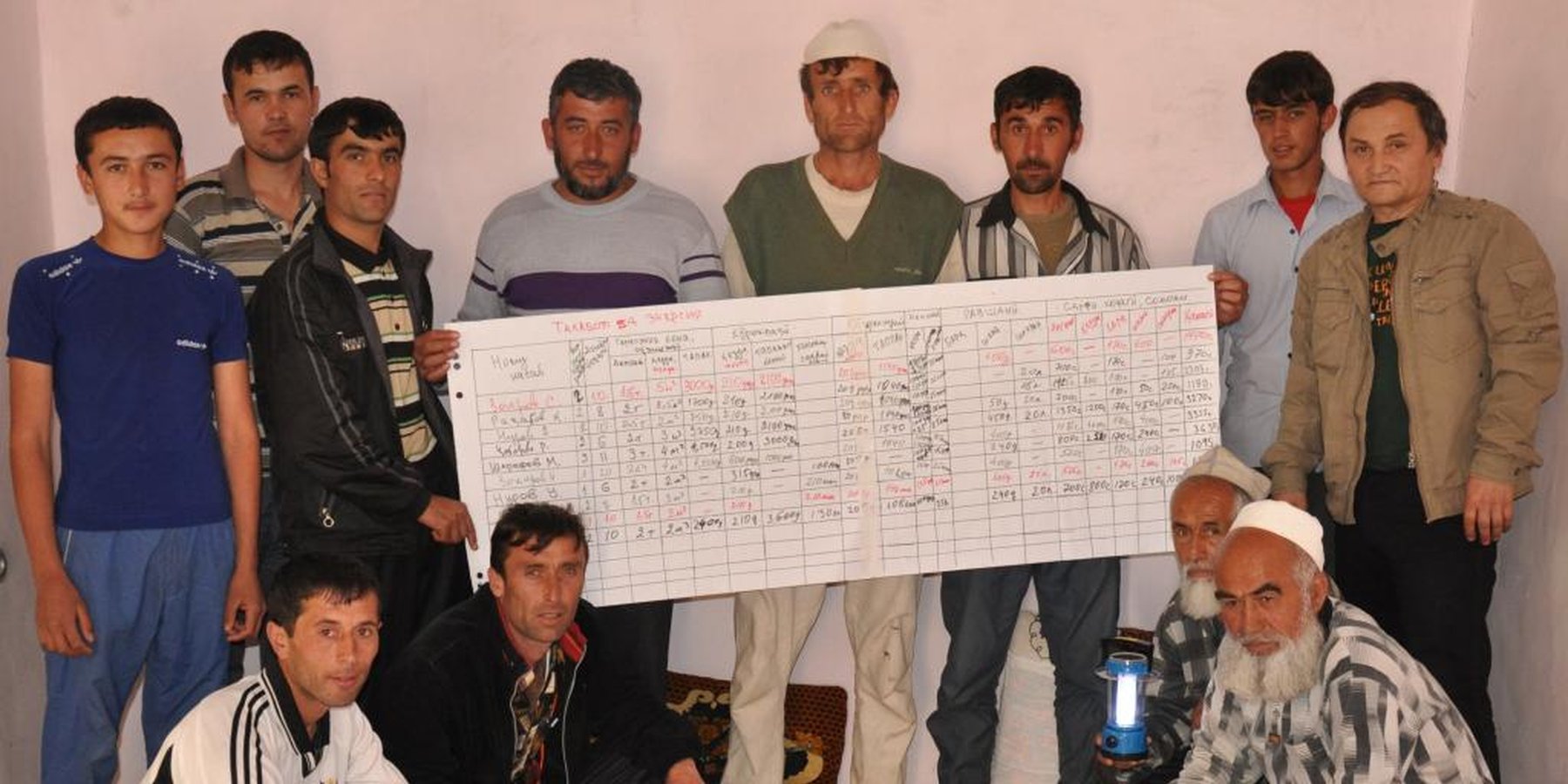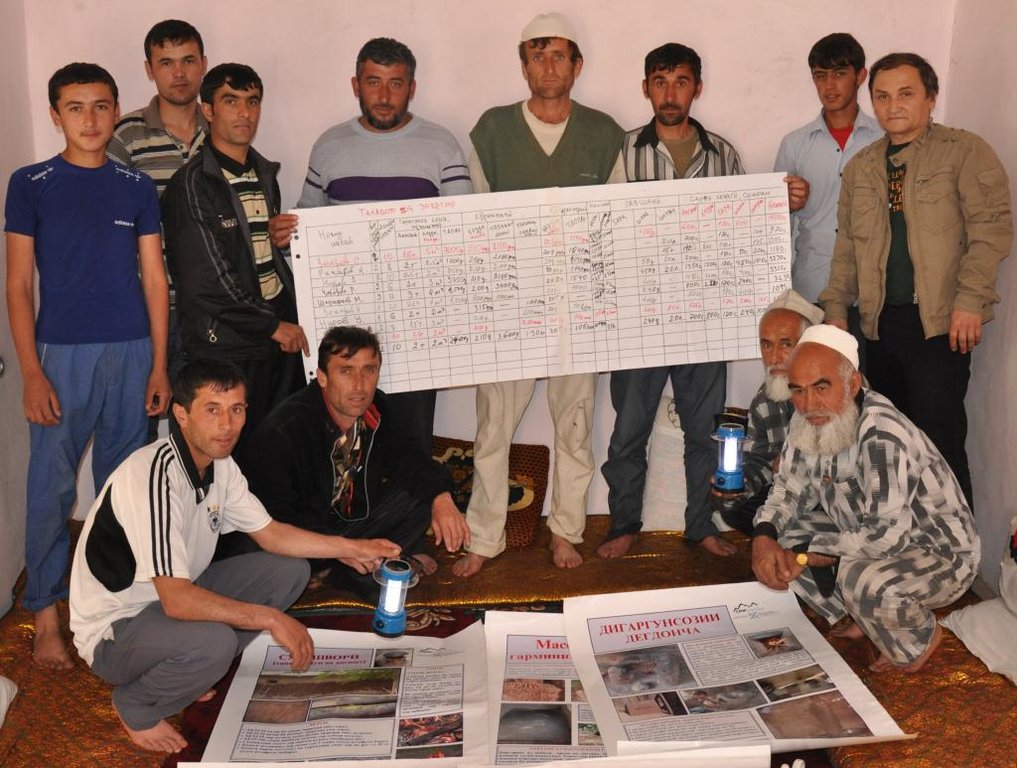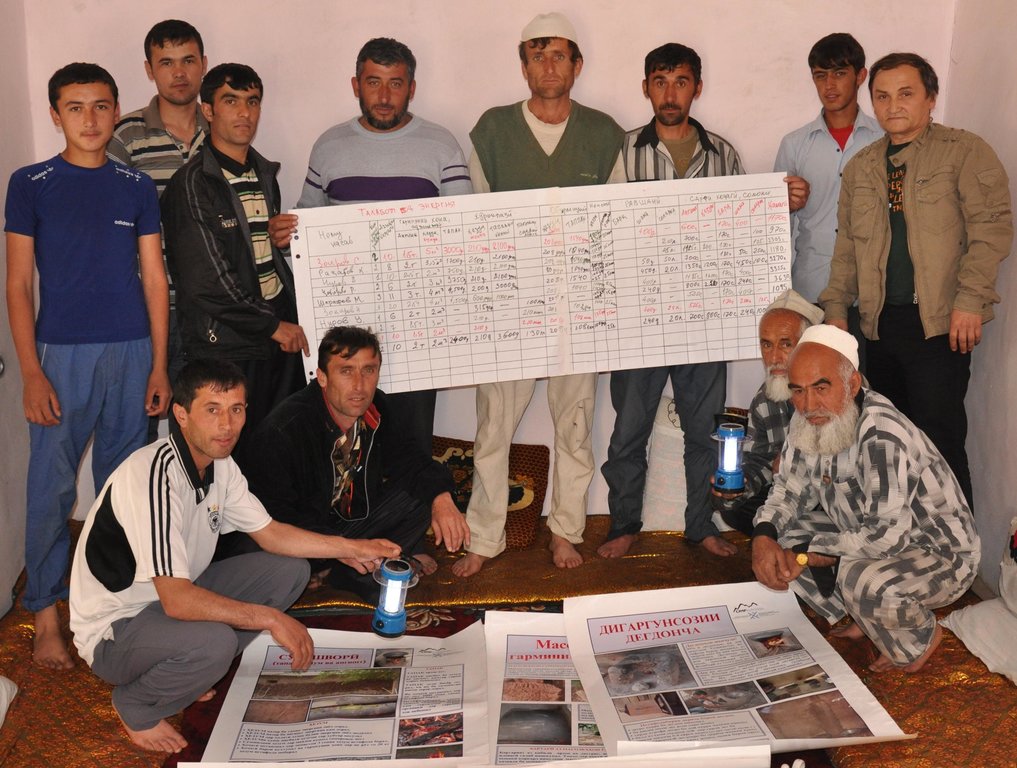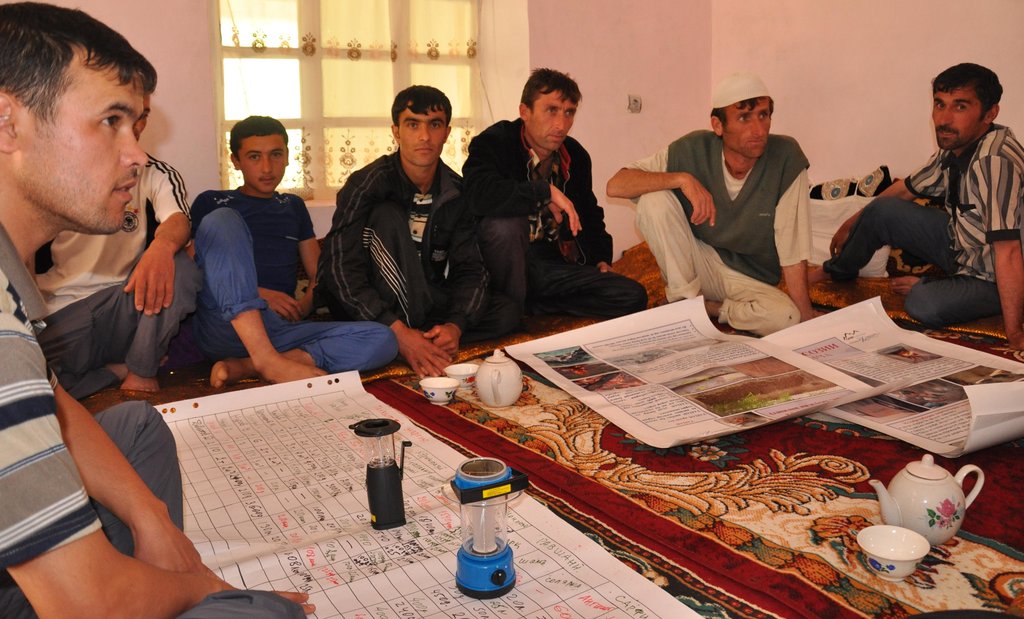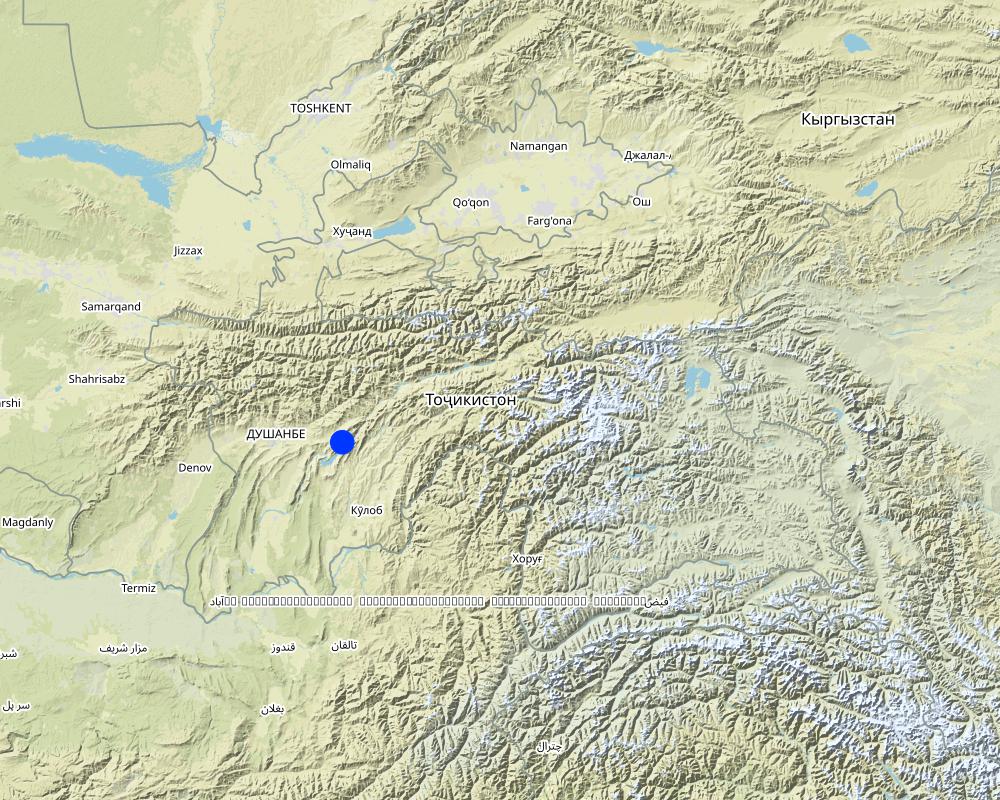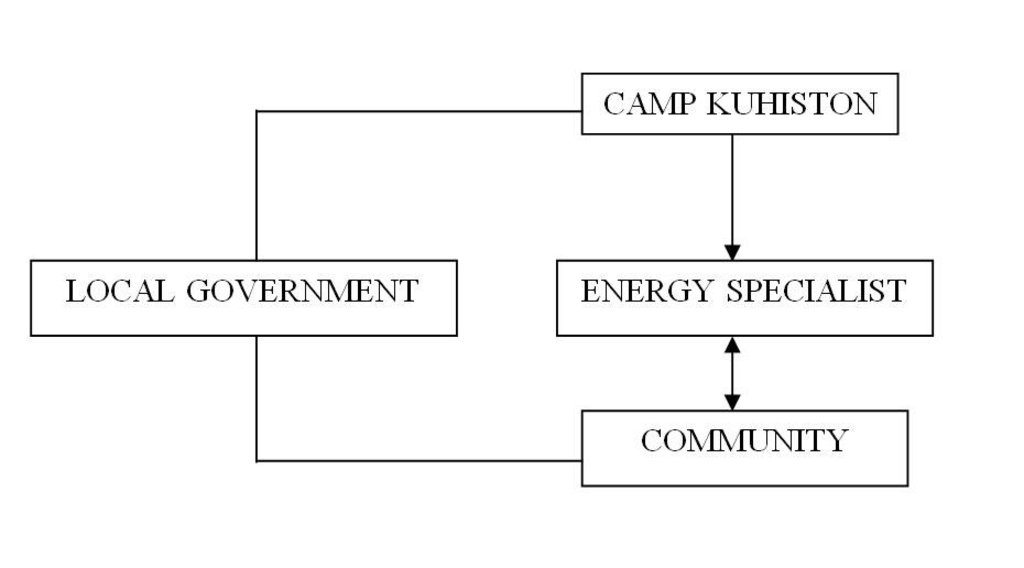Participatory Cost Benefit Analysis for Energy Efficiency Measures [ຕາຈິກິສະຕານ]
- ການສ້າງ:
- ປັບປູງ:
- ຜູ້ສັງລວມຂໍ້ມູນ: shane stevenson
- ບັນນາທິການ: –
- ຜູ້ທົບທວນຄືນ: David Streiff, Alexandra Gavilano, Joana Eichenberger
approaches_2442 - ຕາຈິກິສະຕານ
ເບິ່ງພາກສ່ວນ
ຂະຫຍາຍທັງໝົດ ຍຸບທັງໝົດ1. ຂໍ້ມູນທົ່ວໄປ
1.2 ລາຍລະອຽດ ການຕິດຕໍ່ ຂອງບຸກຄົນທີ່ຊັບພະຍາກອນ ແລະ ສະຖາບັນ ການມີສ່ວນຮ່ວມ ໃນການປະເມີນຜົນ ແລະ ເອກະສານ ຂອງວິທີທາງ
ຜູ້ຊ່ຽວຊານ ດ້ານການຄຸ້ມຄອງ ທີ່ດິນແບບຍືນຍົງ:
Pochoev Mirzo
992 44 601 55 05
CAMP Kuhiston
Dushanbe
ຕາຈິກິສະຕານ
ຊື່ຂອງໂຄງການ ທີ່ອໍານວຍຄວາມສະດວກ ໃນການສ້າງເອກກະສານ ຫຼື ປະເມີນດ້ານແນວທາງ (ຖ້າກ່ຽວຂ້ອງ)
Pilot Program for Climate Resilience, Tajikistan (WB / PPCR)ຊື່ຂອງ ສະຖາບັນການຈັດຕັ້ງ ທີ່ອໍານວຍຄວາມສະດວກ ໃນການສ້າງເອກກະສານ ຫຼື ປະເມີນແນວທາງ (ຖ້າກ່ຽວຂ້ອງ)
CAMP - Central Asian Mountain Partnership (CAMP - Central Asian Mountain Partnership) - ກີກັດຕັນ1.3 ເງື່ອນໄຂ ຂອງການນໍາໃຊ້ເອກກະສານຂໍ້ມູນ ຂອງ WOCAT
ເມື່ອໃດທີ່ໄດ້ສັງລວມຂໍ້ມູນ (ຢູ່ພາກສະໜາມ)?
25/04/2011
ຜູ້ສັງລວມ ແລະ ບັນດາຜູ້ຕອບແບບສອບຖາມ ຍອມຮັບໃນເງື່ອນໄຂ ການນໍາໃຊ້ຂໍ້ມູນເອກະສານ ທີ່ສ້າງຂື້ນ ໂດຍຜ່ານ ອົງການ WOCAT:
ແມ່ນ
1.4 ເອກະສານອ້າງອີງ (ຫຼາຍ) ກັບແບບສອບຖາມ (ຫຼາຍ) ເຕັກໂນໂລຢີ ຂອງດ້ານການຄຸ້ມຄອງ ດິນແບບຍືນຍົງ
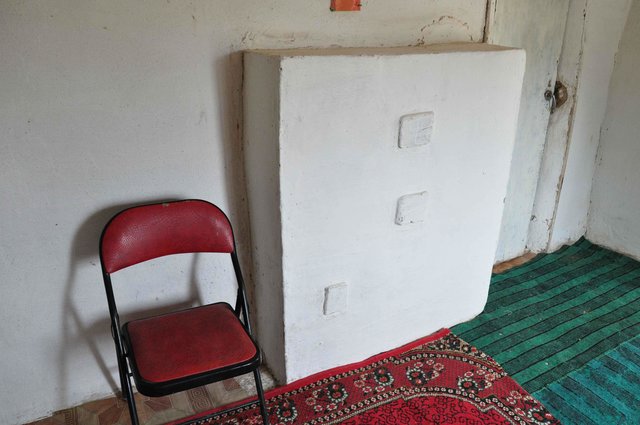
Two Room Stove [ຕາຈິກິສະຕານ]
A brick stove that is built into the existing internal wall, that will heat the two rooms and can be used for cooking.
- ຜູ້ສັງລວມຂໍ້ມູນ: shane stevenson
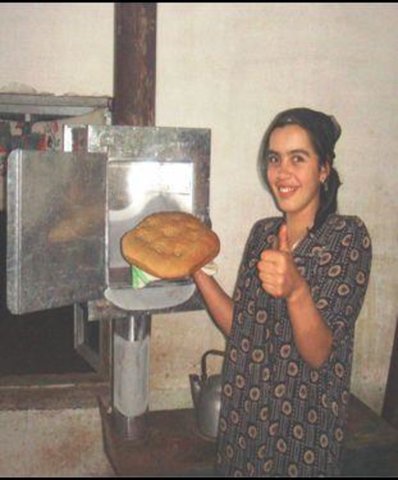
Energy efficiency measures to increase the application of … [ຕາຈິກິສະຕານ]
The implementation of several low cost energy efficiency measures to reduce the amount of organic material used as fuel within rural households.
- ຜູ້ສັງລວມຂໍ້ມູນ: Daler Domullojonov
2. ພັນລະນາ ແນວທາງການຄຸ້ມຄອງນໍາໃຊ້ດິນແບບຍືນຍົງ
2.1 ການອະທິບາຍ ໂດຍຫຍໍ້ ຂອງວິທີທາງ
The use of a cost benefit analysis approach to assess the financial and natural resource needs for energy consumption at community level, and further attribute costs to SLM practices to meet this need, and subsequently improve rural livelihoods.
2.2 ການອະທິບາຍ ລາຍລະອຽດ ຂອງວິທີທາງ
ການອະທິບາຍ ລາຍລະອຽດ ຂອງວິທີທາງ:
Aims / objectives: To collate quantitative data on the amount of energy used within the community in terms of financial expenditure and natural resource use. Through the use of a participatory workshop the attendees determine which natural resources are being utilised, in the form of wood, bush and organic materials. The objective is to use this quantitative data to encourage through cost benefit demonstrations, the implementation of Sustainable Land Management technologies to reduce the amount of natural resources exploited, and the expenditure on energy consumption.
Methods: An energy specialist organises a community based workshop with up to 15 participants. In the 2-3hr workshop the participants complete, under guidance, a pre prepared flip chart on energy use (electric, tapak, wood, coal, brush). The information is collected in financial expenditure and weight. Once the energy assessment is completed a subsequent discussion is encouraged on how to more effectively meet this need at a community level. The moderator also takes this oppoprtunity to demonstrate several technologies including solar lights, improved stove design, thermal insulation, and the development of energy forests. The information is collated and used as a baseline assessment for evaluation of implemented technologies.
Stages of implementation: The stages of implementation are relatively straight forward. First you must select the community that you wish to work in, and inform a community mobiliser, in this case the head of the village that you wish to conduct a 2-3 hr workshop for up to 15 participants, and that the participants must be the person in the households who is responsible (or has knowledge of) the energy use within the household. The moderator prepares a flip chart with a table of fuel types used in the village and uses this as the basis of the workshop to extract information on energy use within the community. Once the information is collated, a discussion is encouraged to review the information and devise means by which this amount can be reduced. The moderator then takes this opportunity to demonstrate several low cost energy efficiency measures that may appeal to the community.
Role of stakeholders: The community are expected to attend the workshop, engage in active discussions on their energy use and ways in which it can be reduced. The workshop needs to be supported by the local government, this provides gravitas, and a platform to launch the approach in other communities. The final stakeholder is the implementer, in this case a local NGO who organises the workshop, demonstrates the technologies and provides ongoing support during the implementation of the technologies.
Other important information: It is important to understand the spending habits of the participants, if they are used to spending on a day to day basis and not used to financial planning, it is important to recognise this fact in the implementation of the technology.
2.3 ຮູບພາບຂອງແນວທາງ
2.5 ປະເທດ / ເຂດ / ສະຖານທີ່ບ່ອນທີ່ແນວທາງໄດ້ຖືກນໍາໃຊ້
ປະເທດ:
ຕາຈິກິສະຕານ
ພາກພື້ນ / ລັດ / ແຂວງ:
RRS
ຂໍ້ມູນເພີ່ມເຕີມຂອງສະຖານທີ່:
Nurobod, Shaftuti Bolo
Map
×2.6 ວັນທີເລີ່ມຕົ້ນ ແລະ ສິ້ນສຸດ ການຈັດຕັ້ງປະຕີບັດ ວິທີທາງ
ສະແດງປີຂອງການເລີ່ມຕົ້ນ:
2011
ປີທີ່ສີ້ນສູດ (ຖ້າຢຸດບໍ່ໄດ້ນໍາໃຊ້ ວິທີທາງ):
2012
2.7 ປະເພດຂອງແນວທາງ
- ພາຍໃຕ້ໂຄງການ / ແຜນງານ
2.8 ເປົ້າໝາຍ / ຈຸດປະສົງຫຼັກ ຂອງການຈັດຕັ້ງປະຕິບັດ ວິທີທາງ
The Approach focused mainly on SLM with other activities (Energy Conservation)
There were two main objectives to this approach, the first was to raise awareness on energy use with respect to types of energy, cost and accessibility, and to use this as a platform for encouraging the implementation of low cost energy efficiency measures in the community. The second was to collate baseline data to allow an assessment of how the implemented technologies impacted on energy (and by association natural resources) use and how the expenditure and amounts were reduced in real terms.
The SLM Approach addressed the following problems: This approach was designed to make the participants evaluate and assess the amount of money, time and effort that goes into meeting their energy needs. It is also a clear and precise way to collate information on the amount of natural resources that are been used to meet this need. These natural resources can be in the form on bushes, wood, dung, cotton sticks etc. These resources are being redirected from other purposes such as construction, but also as natural fertilisers, mulch and compost. This directly impacts on agricultural production, household finance and ultimately livelihoods. The reduction in resource use can reduce the risk of conflicts between villages, and reduce pressure on natural resources allowing them to rejuvenate, and increase soil fertility and quality.
2.9 ເງື່ອນໄຂອໍານວຍ ຫຼື ຂັດຂວາງການປະຕິບັດຂອງເຕັກໂນໂລຢີ / ເຕັກໂນໂລຢີການນໍາໃຊ້ຕາມແນວທາງ
ສັງຄົມ / ວັດທະນະທໍາ / ມາດຕະຖານ ແລະ ຄຸນຄ່າທາງສາສະໜາ
- ເຊື່ອງຊ້ອນ
Rural communities emerging from the soviet system have very low business awareness. Even when there are seemingly obvious savings to be made in finance and natural resources there is a lack of appreciation of the potential savings that could be made.
Treatment through the SLM Approach: Discussion on the issue of savings in time, money and resources helps promote better understanding. The concept of pay back had to be repeatedly explained.
ກ່ຽວກັບກົດໝາຍ (ສິດນໍາໃຊ້ດິນ, ສິດນໍາໃຊ້ນໍ້າ)
- ອໍານວຍ
- ເຊື່ອງຊ້ອນ
ວຽກ, ມີກໍາລັງຄົນ
- ເຊື່ອງຊ້ອນ
There are times of year when the village participants are otherwise distracted by sowing seeds, harvesting, Ramadan etc.
Treatment through the SLM Approach: The most effective time would be at the end of the winter period when resources are scarce, money constraints are more apparent and energy use is a household priority issue.
ອື່ນໆ
- ເຊື່ອງຊ້ອນ
In many of the households the men are working away in Russia. This leaves the women in charge of the household, however, many of the energy costs are organised by the men before they leave or on their return.
Treatment through the SLM Approach: Many of the labour migrant leave in the springtime, therefore it would be more effective to organise the workshops at the end of the winter before they leave.
3. ການມີສ່ວນຮ່ວມ ແລະ ບົດບາດຂອງພາກສ່ວນທີ່ກ່ຽວຂ້ອງທີ່ໄດ້ມີສ່ວນຮ່ວມ
3.1 ຜູ້ມີສ່ວນຮ່ວມ ໃນວິທີທາງ ແລະ ພາລະບົດບາດ ຂອງເຂົາເຈົ້າ
- ຜູ້ນໍາໃຊ້ດິນໃນທ້ອງຖິ່ນ / ຊຸມຊົນທ້ອງຖິ່ນ
A representative from each household in the community was involved.
Women hold a traditional role in the society and did not participate in the workshops. The men pay all the bills and see their role as that of the provider for the family.
The entire village suffers from mass labour migration, with nearly all households reliant upon remittances from Russia.
- ຜູ້ຊ່ຽວຊານ ການນຄຸ້ມຄອງ ທີ່ດິນແບບຍືນຍົງ / ທີ່ປຶກສາດ້ານກະສິກໍາ
International support and finance was provided for this approach, however, the questionnaire was developed in collaboration between national and international staff to ensure relevance and applicability to the context.
- ອົງການຈັດຕັ້ງ ທີ່ບໍ່ຂື້ນກັບລັດຖະບານ
CAMP Kuhiston
ຖ້າຫາກມີຫຼາຍພາກສ່ວນທີ່ເຂົ້າຮ່ວມ ໃຫ້ລະບຸ ອົງການທີ່ເປັນຫຼັກ ໃນການຈັດຕັ້ງປະຕິບັດ:
CAMP Kuhiston
3.2 ການມີສ່ວນຮ່ວມຂອງຜູ້ນໍາໃຊ້ທີ່ດິນໃນທ້ອງຖິ່ນ / ຊຸມຊົນທ້ອງຖິ່ນໃນໄລຍະທີ່ແຕກຕ່າງກັນຂອງແນວທາງ
| ການລວບລວມ ເອົາຜູ້ນໍາໃຊ້ດິນ ໃນທ້ອງຖິ່ນ / ຊຸມຊົນທ້ອງຖິ່ນ | ໃຫ້ລະບຸ ຜູ້ໃດທີ່ມີສ່ວນຮ່ວມ ໃນແຕ່ລະກິດຈະກໍາ? | |
|---|---|---|
| ການເລີ່ມຕົ້ນ / ແຮງຈູງໃຈ | ບໍ່ມີ | |
| ການວາງແຜນ | ບໍ່ມີ | |
| ການປະຕິບັດ | ການນໍາໃໍຊ້ເອງ | they were active in the participation in the workshops and the collation of data. |
| ຕິດຕາມກວດກາ / ການປະເມີນຜົນ | ການຊ່ວຍເຫຼືອຈາກພາຍນອກ | Active in providing follow-up data to evaluate the success of the project. |
| Research | ບໍ່ມີ |
3.3 ແຜນວາດ (ຖ້າມີ)
ການອະທິບາຍ:
The project employs an energy specialist to conduct a participatory workshop. The process is supported by the local government.
ຜູ້ຂຽນ:
S. Stevenson (CAMP Kuhiston, Dushanbe)
3.4 ການຕັດສິນໃຈກ່ຽວກັບການຄັດເລືອກເຕັກໂນໂລຢີຂອງການຄຸ້ມຄອງທີ່ດິນແບບຍືນຍົງ / ເຕັກໂນໂລຢີ
ລະບຸ ຄົນທີ່ຕັດສິນໃຈ ກ່ຽວກັບການຄັດເລືອກຂອງ ເຕັກໂນໂລຢີ / ເຕັກໂນໂລຢີ ຈະໄດ້ຮັບການປະຕິບັດ:
- ຜູ້ນໍາໃຊ້ທີ່ດິນຫຼັກ, ການສະໜັບສະໜູນ ໂດຍຜູ້ຊ່ຽວຊານ ການນໍາໃຊ້ທີ່ດິນແບບຍືນຍົງ
ອະທິບາຍ:
The participants are presented with a range of potential energy efficiency technologies such as stove adaptation, thermal insulation by experts, however, it is the participants decision as to which technologies are the most appropriate for their communtiy, and how they can implemented.
Decisions on the method of implementing the SLM Technology were made by mainly by land users supported by SLM specialists. One technology involved the adaptation of traditional cooking stoves; demonstrations were provided however, the mechanisms for securing the materials and ensuring the entire village implemented the technology were up to the discretion of the participants.
4. ການສະໜັບສະໜູນທາງດ້ານວິຊາການ, ການສ້າງຄວາມສາມາດ, ແລະ ການຈັດການຄວາມຮູ້.
4.1 ການສ້າງຄວາມສາມາດ / ການຝຶກອົບຮົມ
ຜູ້ນໍາໃຊ້ທີ່ດິນ ຫຼື ພາກສ່ວນກ່ຽວຂ້ອງອື່ນໆ ໄດ້ຮັບການຝຶກອົບຮົມບໍ່?
ແມ່ນ
ໃຫ້ລະບຸ ຜູ້ໃດທີ່ໄດ້ຮັບການຝຶກອົບຮົມ:
- ຜູ້ນໍາໃຊ້ດິນ
ຖ້າເປັນໄປໄດ້, ໃຫ້ລະບຸເພດ, ອາຍຸ, ສະຖານະພາບ, ຊົນເຜົ່າ, ແລະ ອື່ນໆ:
The initial training was for all the households in the village, however, only the men attended due to the religious and cultural position of the region.
ຮູບແບບຂອງການຝຶກອົບຮົມ:
- ຫຼັກສູດ
ໃນຫົວຂໍ້:
The training included raising awareness on stove adaptation, indoor two room stove construction, solar power, and low cost thermal insulation for rooms.
4.2 ການບໍລິການໃຫ້ຄໍາປຶກສາ
ເຮັດຜູ້ໃຊ້ທີ່ດິນມີການເຂົ້າເຖິງການບໍລິການໃຫ້ຄໍາປຶກສາ?
ບໍ່ແມ່ນ
4.3 ສະຖາບັນການສ້າງຄວາມເຂັ້ມແຂງ (ການພັດທະນາອົງການຈັດຕັ້ງ)
ສະຖາບັນ ໄດ້ຮັບການສ້າງຕັ້ງຂື້ນ ຫຼື ໄດ້ຮັບການສ້າງຄວາມເຂັ້ມແຂງ ໂດຍການຈັດຕັ້ງປະຕິບັດ ວິທີທາງບໍ່?
- ມີ, ພໍສົມຄວນ
ລະບຸ ທາງສະຖາບັນ ໄດ້ສ້າງຄວາມເຂັ້ມແຂງ ໃນລະດັບໃດ (ຫຼາຍ):
- ທ້ອງຖິ່ນ
ລະບຸ ປະເພດ ຂອງສະໜັບສະໜູນ:
- ທາງດ້ານການເງິນ
ໃຫ້ລາຍລະອຽດເພີ່ມເຕີມ:
The Jephcott Foundation financed local NGO CAMP Kuhiston to implement the approach.
4.4 ຕິດຕາມກວດກາ ແລະ ປະເມີນຜົນ
ການຈັດຕັ້ງປະຕິບັດ ວິທີທາງ ໄດ້ມີການປະເມີນຜົນ ແລະ ຕິດຕາມບໍ?
ແມ່ນ
ຄວາມຄິດເຫັນ:
socio-cultural aspects were regular monitored by project staff through observations; indicators: Observations of participants understanding of economic benefits.
management of Approach aspects were ad hoc monitored by None through observations; indicators: international staff monitor the set up of the workshops and levels of participation.
There were few changes in the Approach as a result of monitoring and evaluation: The timing of the workshops (i.e the time of year) will be changed to the end of the winter when energy use is more of a priority issue, e.g. cold weather, poor electric supply, lack of easily accessible natural resources
There were no changes in the Technology as a result of monitoring and evaluation: None
4.5 ການຄົ້ນຄວ້າ
ນີ້້ແມ່ນສ່ວນໜຶ່ງ ການຄົ້ນຄວ້າ ຂອງວິທີທາງບໍ່?
ແມ່ນ
ລະບຸ ຫົວຂໍ້:
- ສັງຄົມ
- ເສດຖະສາດ / ການຕະຫຼາດ
ໃຫ້ຂໍ້ມູນ ເພີ່ມເຕີມ ແລະ ກໍານົດ ຜູ້ໃດເຮັດການຄົ້ນຄວ້າ:
CAMP Kuhiston collated data on energy usage and by association natural resource use. In addition to the participatory workshop CAMP conducted a household questionnaire to assess the suitability of different energy efficiency technologies, and the social vulnerability of the inhabitants, to identify the most effective households to implement energy saving activities.
Research was carried out on-farm
5. ການສະໜັບສະໜູນທາງດ້ານການເງິນ ແລະ ອຸປະກອນຈາກພາຍນອກ
5.1 ງົບປະມານປະຈໍາປີ ສໍາລັບວິທີທາງ ຂອງການຄຸ້ມຄອງ ທີ່ດິນແບບຍືນຍົງ
ຖ້າຫາກບໍ່ຮູ້ຈັດງົບປະມານທີ່ແນ່ນອນ ແມ່ນໃຫ້ປະມານເອົາ:
- < 2,000
ຄໍາເຫັນ (ຕົວຢ່າງ: ແຫຼ່ງຂໍ້ມູນຫຼັກ ຂອງການສະໜອງທຶນ / ຜູ້ໃຫ້ທຶນທີ່ສໍາຄັນ):
Approach costs were met by the following donors: international non-government (Jephcott Foundation, UK): 100.0%
5.2 ການສະໜັບສະໜູນ ທາງດ້ານການເງິນ / ອຸປະກອນ ສະໜອງໃຫ້ແກ່ຜູ້ນໍາທີ່ດິນ
ຜູ້ນໍາໃຊ້ດິນ ໄດ້ຮັບການສະໜັບສະໜູນ ທາງດ້ານ ການເງິນ / ອຸປະກອນ ໃນການຈັດຕັ້ງປະຕິບັດ ເຕັກໂນໂລຢີບໍ?
ບໍ່ແມ່ນ
5.3 ເງິນສົມທົບສໍາລັບການນໍາໃຊ້ສະເພາະປັດໃຈຂາເຂົ້າໃນການຜະລີດກະສິກໍາ (ລວມທັງແຮງງານ)
- ອຸປະກອນ
| ໃຫ້ລະບຸໄດ້ຮັບການສະໜັບສະໜູນປັດໃຈຂາເຂົ້າຫຍັງແດ່ | ທີ່ຂອບເຂດ | ລະບຸ ການອຸດໜູນ |
|---|---|---|
| Posters and stationery | ງົບປະມານເຕັມສ່ວນ | |
- ການກໍ່ສ້າງ
| ໃຫ້ລະບຸໄດ້ຮັບການສະໜັບສະໜູນປັດໃຈຂາເຂົ້າຫຍັງແດ່ | ທີ່ຂອບເຂດ | ລະບຸ ການອຸດໜູນ |
|---|---|---|
| Metal sheets, demonstration material | ງົບປະມານເຕັມສ່ວນ | |
ຄວາມຄິດເຫັນ:
Metal sheets and some other basic materials were provided for the demonstration adaptation of the outdoor cooking stoves.
5.4 ສິນເຊື່ອ
ໄດ້ປ່ອຍສິນເຊື່ອ ສະໜອງໃຫ້ພາຍໃຕ້ ວິທີການສໍາລັບກິດຈະກໍາ ການຄຸ້ມຄອງ ທີ່ດິນແບບຍືນນຍົງບໍ່?
ບໍ່ແມ່ນ
5.5 ສິ່ງຈູງໃຈ ຫຼື ເຄື່ອງມືອື່ນໆ
ການສົ່ງເສີມ ຈັດຕັ້ງປະຕິບັດ ເຕັກໂນໂລຢີ ໃນການຄຸ້ມຄອງ ດິນແບບຍືນຍົງ ໄດ້ສະໜອງສິ່ງກະຕຸກຊຸກຍູ້ບໍ່?
ແມ່ນ
ຖ້າແມ່ນ, ໃຫ້ລະບຸ:
The Jephcott Foundation financed local NGO CAMP Kuhiston to implement the approach.
6. ວິເຄາະຜົນກະທົບ ແລະ ສັງລວມບັນຫາ
6.1 ຜົນກະທົບຂອງແນວທາງ
ການຈັດຕັ້ງປະຕິບັດ ວິທີທາງ ສາມາດຊ່ວຍຜູ້ນໍາໃຊ້ທີ່ດິນ ໃນການຈັດຕັ້ງປະຕິບັດ ແລະ ບໍາລຸງຮັກສາ ເຕັກໂນໂລຢີ ການຄຸ້ມຄອງ ທີ່ດິນແບບຍືນຍົງໄດ້ບໍ?
- ບໍ່
- ມີ, ໜ້ອຍໜຶ່ງ
- ມີ, ພໍສົມຄວນ
- ມີ, ຫຼາຍ
The extent to which it will reduce the amount and type of natural resource use will be re assessed at the end of the project. It is estimated that there will be a 20% reduction.
ການຈັດຕັ້ງປະຕິບັດ ວິທີທາງ ສາມາດສ້າງຄວາມເຂັ້ມແຂງ ທາງສັງຄົມ ແລະ ເສດຖະກິດບໍ່?
- ບໍ່
- ມີ, ໜ້ອຍໜຶ່ງ
- ມີ, ພໍສົມຄວນ
- ມີ, ຫຼາຍ
The approach was implemented in a socially disadvantaged area.
Did other land users / projects adopt the Approach?
- ບໍ່
- ມີ, ໜ້ອຍໜຶ່ງ
- ມີ, ພໍສົມຄວນ
- ມີ, ຫຼາຍ
Did the Approach lead to improved livelihoods / human well-being?
- ບໍ່
- ມີ, ໜ້ອຍໜຶ່ງ
- ມີ, ພໍສົມຄວນ
- ມີ, ຫຼາຍ
The stove adaptation should lead to a 10-20% reduction in natural resources used for cooking, and the solar lights could make a $100/year saving.
Did the Approach help to alleviate poverty?
- ບໍ່
- ມີ, ໜ້ອຍໜຶ່ງ
- ມີ, ພໍສົມຄວນ
- ມີ, ຫຼາຍ
It should help reduce spending on energy, dependence on natural resources, and increase the amount of organic materials for agricultural purposes.
6.2 ແຮງຈູງໃຈຫຼັກຂອງຜູ້ນໍາໃຊ້ທີ່ດິນໃນການປະຕິບັດການຄຸ້ມຄອງທີ່ດິນແບບຍືນຍົງ
- ກໍາໄລເພີ່ມຂຶ້ນ (ຄວາມສາມາດ), ການປັບປຸງຄ່າໃຊ້ຈ່າຍ, ຜົນປະໂຫຍດ, ອັດຕາສ່ວນ
The approach is designed to highlight to households how much of their income they spend on energy.
- ກຽດສັກສີ, ຄວາມກົດດັນທາງສັງຄົມ / ການຕິດຕໍ່ກັນທາງສັງຄົມ
Social pressure ensured all the households participated.
- well-being and livelihoods improvement
Improvement in living conditions and saving of finance and natural resources.
6.3 ຄວາມຍືນຍົງຂອງກິດຈະກໍາວິທີທາງ
ຜູ້ນໍາໃຊ້ ທີ່ດິນ ສາມາດສືບຕໍ່ ການຈັດຕັ້ງປະຕິບັດ ຜ່ານວິທີທາງໄດ້ບໍ່ (ໂດຍປາດສະຈາກ ການຊ່ວຍເຫຼືອ ຈາກພາກສ່ວນພາຍນອກ)?
- ບໍ່ແນ່ນອນ
ຖ້າ ບໍ່ ຫຼື ບໍ່ແນ່ໃຈ, ໃຫ້ອະທິບາຍ ແລະ ຄໍາເຫັນ:
The participants will be encouraged to re-assess their natural resource use in the following year, and hopefully instigate their own measures to tackle the issue.
6.4 ຈຸດແຂງ / ຂໍ້ດີ ຂອງວິທີທາງ
| ຈຸດແຂງ / ຂໍ້ດີ / ໂອກາດໃນການນໍາໃຊ້ທີ່ດິນ |
|---|
| Quick and simple way to put an economic cost on fuel use. |
| ຈຸດແຂງ / ຈຸດດີ / ໂອກາດ ຈາກທັດສະນະຂອງຜູ້ປ້ອນຂໍ້ມູນ ຫຼື ບຸກຄົນສຳຄັນ |
|---|
| The approach needs minimal resources and is relatively easy to implement. (How to sustain/ enhance this strength: It would be easy to replicate and easy to teach others how to undertake the approach.) |
| It makes participants evaluate what they need to run their households, and puts an economic and natural resource value on the process. |
| It helps focus the participants on how much time, effort and money are being used to run their household. (How to sustain/ enhance this strength: To follow up, to see how effective the implementation of the technologies was in reducing their energy needs.) |
| The scope of the level of participation is flexible and can be adapted to the contexts. It allows for direct comparison for before and after the implementation of the technology. (How to sustain/ enhance this strength: It could be further developed to put an economic value on SLM technologies.) |
6.5 ຈຸດອ່ອນ / ຂໍ້ເສຍຂອງແນວທາງ ແລະ ວິທີການແກ້ໄຂໃຫ້ເຂົາເຈົ້າ
| ຈຸດອ່ອນ ຫຼື ຂໍ້ເສຍ ຫຼື ຄວາມສ່ຽງ ໃນມຸມມອງຂອງ ຜູ້ສັງລວມຂໍ້ມູນ ຫຼື ບັນດາຜູ້ຕອບແບບສອບຖາມ | ມີວິທີການແກ້ໄຂຄືແນວໃດ? |
|---|---|
| It requires participants to have good quality data available to be effective. | Complete follow up visits to households to check data quality. |
7. ເອກກະສານອ້າງອີງ ແລະ ຂໍ້ມູນການເຊື່ອມໂຍງ
7.1 ວິທີການ / ແຫຼ່ງຂໍ້ມູນ
- ການໄປຢ້ຽມຢາມພາກສະໜາມ, ການສໍາຫຼວດພາກສະໜາມ
- ການສໍາພາດ ຜູ້ນໍາໃຊ້ທີ່ດິນ
ຂໍ້ມູນການເຊື່ອມຕໍ່ ແລະ ເນື້ອໃນ
ຂະຫຍາຍທັງໝົດ ຍຸບທັງໝົດການເຊື່ອມຕໍ່

Two Room Stove [ຕາຈິກິສະຕານ]
A brick stove that is built into the existing internal wall, that will heat the two rooms and can be used for cooking.
- ຜູ້ສັງລວມຂໍ້ມູນ: shane stevenson

Energy efficiency measures to increase the application of … [ຕາຈິກິສະຕານ]
The implementation of several low cost energy efficiency measures to reduce the amount of organic material used as fuel within rural households.
- ຜູ້ສັງລວມຂໍ້ມູນ: Daler Domullojonov
ເນື້ອໃນ
ບໍ່ມີເນື້ອໃນ


